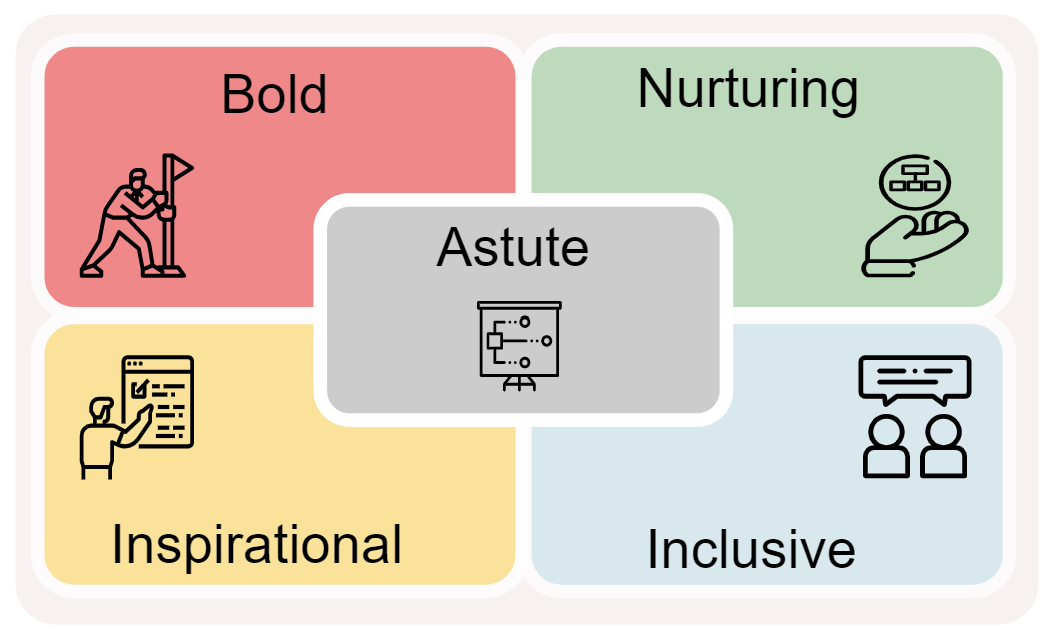Leadership Style
Understand different leadership styles and how they can influence your career.
Introduction to Leadership styles
In business theory, you can find many different leadership styles (including Visionary, Bureaucratic, Transactional, PaceSetter, Servant, Affirmative, Commanding, and Affiliative - to name a few). We have synthesised this thinking into 5 key styles - to draw out simply the most typical leadership approaches in straightforward terms.
Your personal leadership style
In reality, your personal leadership approach will adopt elements from more than one style, not least driven by the situation that you are leading. The goal is to provide you the language to think about your leadership style as part of your career development. Keep in mind that everyone has a chance to lead their peers and upwards, even if they don't have their own team.
5 Styles Leadership Model
In Figure 1 below, you'll find the 5 styles model. The left hand styles (Bold and Inspriational) lead through being more directional. The right hand sides (Nurturing and Inclusive) lead more by pulling on the potential of the team. The central style (Astute) combines both these perspectives, with the ability to enable complex change.

- Astute: able to define, articulate and lead a complex strategy...
- Shares characteristics with styles referred to as 'Transformational' leadership
- Bold: leads from the front, willing to make difficult decisions...
- Shares characteristics with styles referred to as 'Authoritative', 'Directive' and 'Autocratic' leadership
- Inspirational: passionate, respected and loyal, demonstrates respect...
- Shares characteristics with styles referred to as 'Visionary' or 'Charismatic' leadership
- Nurturing: respects concensus, creates structure in which team succeeds...
- Shares characteristics with styles referred to as 'Laissez-faire', or 'Delegative' leadership
- Inclusive: will look for balance between team and business goals...
- Shares characteristics with styles referred to as 'Participative', 'Consultative' and 'Democratic' leadership
Full description of each of these leadership styles is provided in the output of the free assessment.
360 degree Leadership
We follow the leadership definition from Kevin Kruse that "Leadership is a process of social influence, which maximises the efforts of others towards the achievment of a goal". Your leadership style reflects how you lead your colleagues, your manager as well as your team (if you have one). In our leadership assessment we explore the implications of horizontal and vertical leadership for each of the 5 styles.
Take your leadership style assessment
The leadership style assessment in a short questionnaire that helps you identify you preferred leadership style. The assessment is free to carry out and provides an explanations of each of the 5 styles.
Frequently Asked Questions
Is this free?
Yes. Unlike some other leadership style assessments, there are no charges for taking this assessment. You can take the leadership assessment as often as you like without any fee.
Do I have to register to take the assessment?
Yes, you will have to register to take the assessment. This will enable you to keep copies of your assessments and come back in the future to see if / how your assessment evolves. You can delete your account at any time.
How long will it take me to do the Leadership style assessment?
It typically will take under 10 minutes to do the assessment. The format uses a sliding scale which simplifies what you need to do, and we recommend that you don't overthink the answers.
Should I refer to my Leadership style in a job interview?
We do not recommend using leadership style terminology in a career conversation (unless it is clearly required). Instead, we believe that it is better to introduce your preferences by use of examples at appropriate times in the conversation.